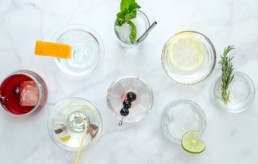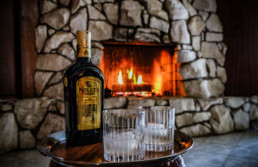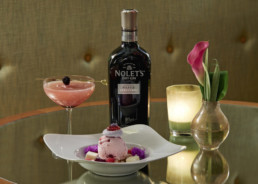Why Gin Is Not Flavored Vodka, Explained.
It is a common misconception that gin is flavored vodka. While the spirits are similar, the ingredients and distilling processes are different. Gin is a little bit more involved in making, as Brian O’Rourke a culinary journalist aptly said, “Gin is the Disneyland of liquor. There is a rich history of gin creation, modification, and exploitation”.
Gin is (and must be by definition) a grain-based spirit (usually wheat or barley) distilled with juniper. Herbaceous and floral, juniper was first used in Dutch genever as a medicinal spirit that dates back to the 13th century, distilled in a wine-base. As distilling techniques advanced, modern gin was born made of neutral grain alcohol and distilled or re-distilled with juniper and other botanicals macerated and then distilled again to impart flavor. In the 1600’s, British soldiers fighting the 30-year war in Holland were given gin to bolster their spirits, known as, “Dutch Courage” in battle. They brought the concept of gin back to the UK, but it took about 150 years to create what’s known as “London Gin.”
Balance characterizes great gin. There are several categories of gins, with a wide range of flavors, citrusy to floral, dry and sweet. The botanicals in gin add a depth of flavor that is seductive to both the nose and the taste buds. There are top, middle and base notes to gin. The top is the most volatile, evaporating first. The middle note packs a punch (and that’s where the juniper lives) and the base notes are usually earthy and bind all the flavors together. There is a considerable amount of creativity in the crafting of gin because outside of the juniper, the botanicals are up to the distiller.
The styles of gin are distinct and different. Modern gins tend to be fragrant and floral with a minimal juniper flavor, while London Dry Gin is on the other end of the spectrum with a juniper-forward taste profile. Old Tom gin is sweet and full-bodied. Plymouth and Genever are earthy in flavor, soft in juniper and less botanical. American gin refers to a new style of gin made of non-traditional botanicals.
By definition, Vodka is a colorless, tasteless, odorless neutral spirit. Commonly associated with Eastern Europe and Russia, vodka’s origins go back to the late 9th century. “Voda” is the Russian word for water.
The variation of vodka is distinguished by the raw materials and distillation processed used. Barley, wheat, and potato are common raw materials used in the making of vodka, and each requires a distinct distilling process.
Cocktail-wise, gin is more of an extrovert, the life of the party, so to speak, used as a mixer that comes to life in combination with other flavors. The effervescence of citrus, tart-sweet of tonic, or the complexities of various fruit juices or liqueurs bring out the botanicals and depth of flavor of gin.
Vodka is enjoyed ice-cold and becomes viscous when chilled which coats the mouth and goes down smooth. Vodka is often enjoyed straight as a shot however it provides a solid nearly flavorless mixer in cocktails.
The most contentious piece in deliberating differences between gin and vodka is the Martini. It may be an ongoing debate, but for purists it’s clear. The classic Martini is made with gin. Vermouth and bitters are optional, garnishes may vary... lemon peel, olives, and cocktail onions are all viable options. The ’correct’ ratio of gin to vermouth is an age-old quandary, but the base spirit is always gin. Historically Vodka ‘Martinis’ were called Kangaroo Cocktails, and they were popular in the 1950’s. The modern Vodka Martini is comprised solely of vodka served in an iconic triangular glass and often served “dirty,” (with a splash of olive juice). The Vesper Martini is a slick compromise, consisting of both gin, vodka and vermouth popularized by James Bond.
Clear? Yes. Both gin and vodka are clear. But as for gin being flavored vodka, the conclusion is a definitive no.
Straight Talk About Neat Gin
Gin, a most versatile spirit, gained it’s popularity as a stellar base for mixing a profusion of cocktails. From “The Bramble” to “The Aviation” to the classic “Bloodhound”, gin is a crucial element in some of the world’s most adventurous cocktails. Gin is the default wingman to Tonic, the super hero wonder twin of Vermouth, and is involved in a polyamorous relationship with a range of citrus juices. Gin is fantastic in all of these cocktails, many of which you can discover in our recipe library, but everything, every now and again, needs some “alone time”.
Craft cocktails are the libations d’ jour; foodie-inspired combinations of intense flavor profiles crowned with extreme garnishes. In a natural reaction to this, “neat” gin is causing a stir for purest gin lovers. Until now, gin has been typecast the straight man, the good cop, or the best supporting actor. The guy who was right in front of her eyes the whole time, but she didn’t realize it until the end of the movie. A great character actor, but maybe not a movie star. What happens when gin is given a shot at the lead role? It may surprise you.
As writer Clay Risen in The Atlantic muses, “On a steamy day straight gin is pure bliss.”
Complex and luxurious to the palate, NOLET’S Reserve Dry Gin is crafted to be the literal gold standard for gin. This is the one that gets the girl; the VIP; the North Star. Served neat, straight up (over ice) or chilled (poured over ice then strained), all the unnecessary mixers and garnishes melt into the background, deemed irrelevant. The exquisite botanical notes, elegant saffron and verbena combine with subtle juniper to create a unique flavour and an exceptional golden spirit; one that needs no mixing. From the aromatics to mellow smooth swirl across the palate, to the aftertaste, the luxury of the Reserve is unequivocal.
It’s time to rediscover gin, in its pure form. Stay gold.
Gin pairings, cocktails and confections.
After a great meal, no matter what is consumed, a sweet finale always punctuates the celebration.
“A match made in heaven” is what we call a couple who are perfectly paired. When food and drinks are paired well, it’s much the same. “Ginstronomy” is a term that Australians are using for their explosion of gin in food pairings. Gin is so versatile that makes good sense. So, it is not crazy for a bright, fruit forward gin like NOLET’S Silver to be paired with a sumptuous dessert. Yes, a dessert… and the result of this marriage is quite pleasing to all the senses.
It makes sense because, “your nose always knows” literally, to coin a cliché. Scientifically, “80% of our flavor experience is actually determined by our sense of smell,” according to Bernard Lahousse, Scientist and Foodpairing® founder. NOLET’S Silver is made with Turkish rose, peach and raspberry botanicals. Take a whiff… the fruity notes come through quite naturally, so it’s easy to smell how the floral bouquet will be quite harmonious with similar flavors (and aromas) in food. They do not need to be literal, rather, they should complement one another, just like that perfect couple.
For example, The Palm Court at the Plaza in NY recently featured NOLET’S in a spectacular multi dimensional summer dessert pairing, exciting and delightful to all the senses. Highlighting the botanicals in NOLET’S Silver began with a riff on peaches n’ cream. Next up was The James’ Peachtree Fizz cocktail which was paired with a Summer Verrine of peach & verbena tea sorbet with raspberry & rose compote, garnished with peach flower, rose petals & grapefruit pearls atop a juniper pound cake. Another option available was a Gin Blush + Hibiscus cocktail that was served with a Hibiscus/Violet Vacherin made of juniper pound cake topped with lychee/rose ice cream, raspberry and rose coulis, coconut cream gelee garnished with violet chantilly, crystallized flowers and blackcurrant pearls. These cocktails are available in our Recipe Section to be paired with desserts of your choosing.
Dessert pairings add an unexpected twist to entertaining and are gaining momentum on menus everywhere. At home, it can be as simple as a standard Silver Gin and Tonic served with an orange peel garnish and orange sorbet for dessert. However and wherever you dine, try sweetening the experience with a sumptuous gin cocktail pairing.




